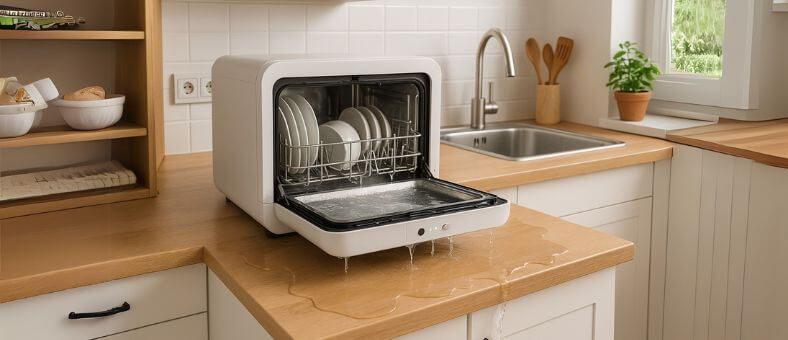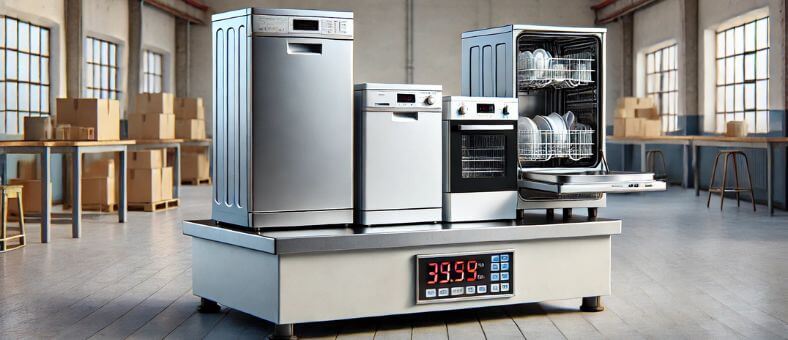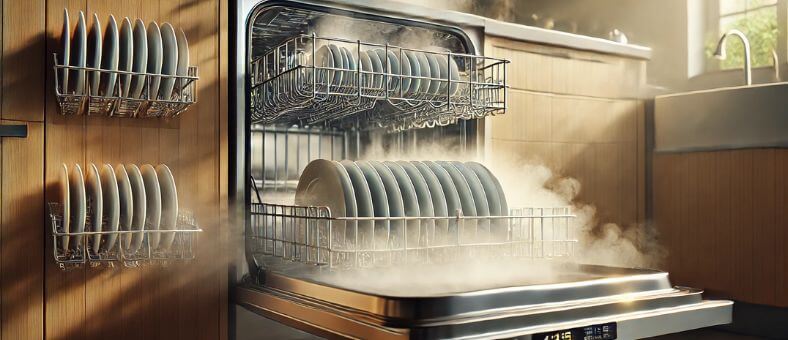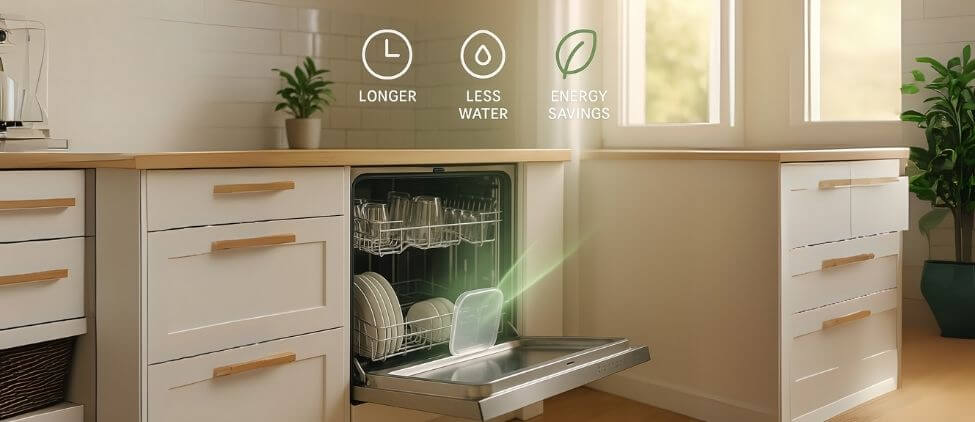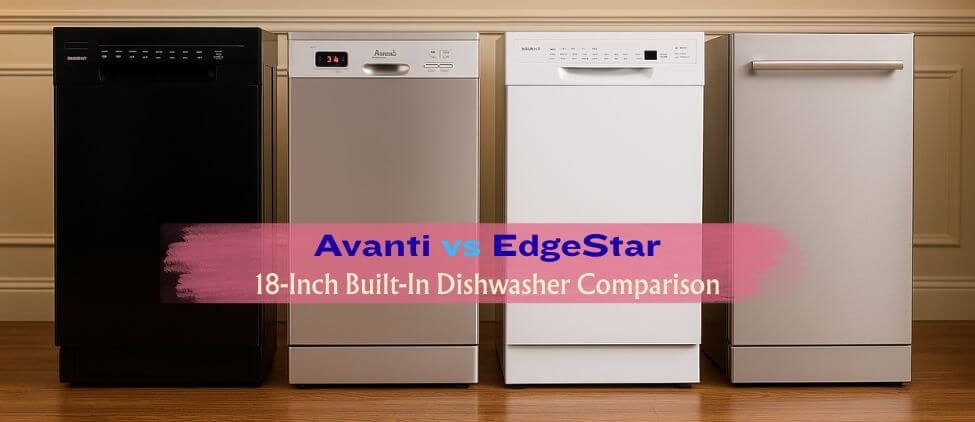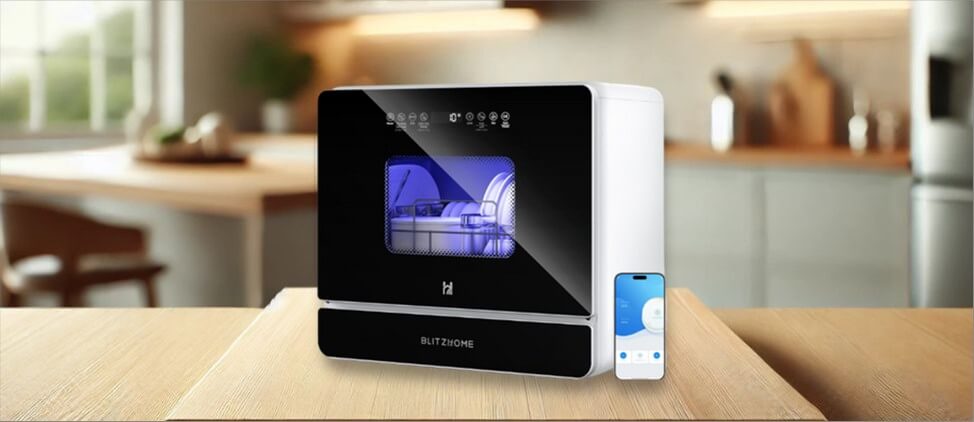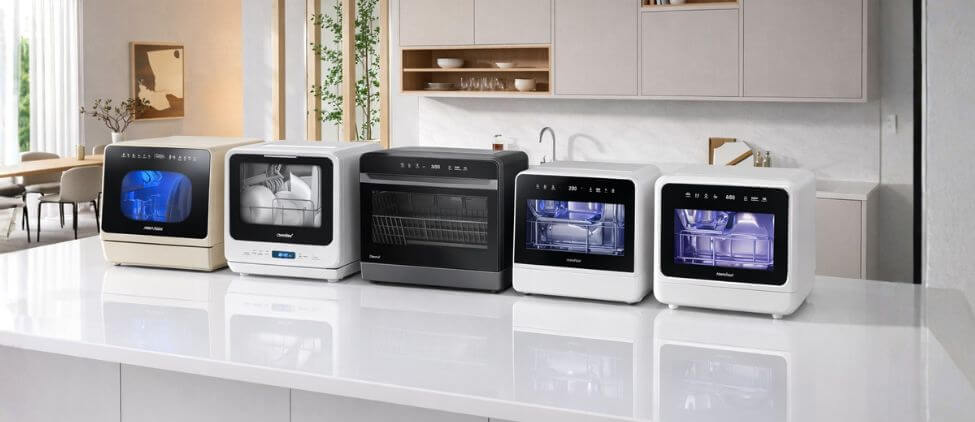Your Dishwasher Won’t Start! Frustrating, isn’t it? But don’t worry – Is your countertop dishwasher not draining and leaving you with a puddle? You’re not the only one to face this watery mystery! But no worries – we have a super-simple guide to help you fix it without needing an expert.
Welcome to “Fix Your Countertop Dishwasher Not Draining in Just 6 Easy Steps!”. This guide is your easy path to going from puzzled to a pro at solving this common kitchen issue without needing a fat wallet or a techy brain.
Why spend big bucks on repairs when you might be able to fix it yourself? With just a little patience and a dash of DIY spirit, you’ll discover you can be the kitchen hero you never knew you were!
The Popularity of Countertop Dishwashers
About 8% of households in the United States have adopted a compact or countertop dishwasher, signifying a growing preference for space-saving appliances, especially among small households and apartment dwellers!
Table of Contents
#1. Ensure the Door is Securely Shut
First things first, let’s talk about that dishwasher door! Just like we can’t start a car without closing the door, our countertop dishwasher also needs its door securely shut to do its job. It’s a simple step but crucial. If the door isn’t closed correctly, water won’t drain – it’s a neat safety feature to avoid kitchen floods! And, by the way, if you’ve ever faced an issue where the dishwasher door unlocks during a cycle, we’ve got a handy guide to troubleshoot that pesky problem too.
A Handy Hint for You
Listen for that “click” sound when you shut the door. No click? The door might be open only some of the way. Give it a gentle push and ensure it’s snugly sealed. Food particles or debris could sometimes be in the way, so a quick wipe around the door seal might do the trick! Easy, right?
# 2. Make Sure the Kitchen Sink is Unobstructed
Moving on, let’s wander over to the kitchen sink. It might seem unrelated, but a clogged sink can be a secret culprit behind your countertop dishwasher not draining. Why? Because most countertop dishwashers are connected to the same pipe as your kitchen sink. If that path is blocked, the water has nowhere to go!
Expert Advice Alert
Before calling it a malfunctioning dishwasher, run the tap and see if the water in the sink drains smoothly. You should roll up those sleeves and clear out any blockages if it doesn’t. You’ll be surprised how often a smooth-sailing sink helps the dishwasher drain effortlessly!
# 3. Purify the Filtering System
Now, let’s delve a little deeper – into the filtering system of the dishwasher. Imagine all the bits of food and particles that might escape from the dishes. Without a good filter, these could clog up the works! Ensuring the filtering system is clean and unobstructed is like ensuring clean waterways in a city. If you’re unsure how to keep that filter in top shape, don’t worry! Check out our guide on Easy Steps to Clean Your Dishwasher Filter to ensure a smooth and clog-free operation.
Don’t Forget This Important Step!
Regularly check and clean the dishwasher filter. It’s typically located at the bottom of the interior and is usually easily removable. Give it a good rinse under the tap, maybe even an old toothbrush scrub for stubborn bits, and you have paved the way for water to exit smoothly!
#4. Confirm the Drain Hose is Properly Connected
Now that we’ve sorted those initial checkpoints, it’s time to dive a tad deeper and peek behind the scenes – or, rather, the dishwasher! That snake-like tube, the drain hose, is our next stop. It’s like the secret tunnel through which the dishwasher sends all the unwanted water away. But sometimes, it might slip or not be fitted securely, disrupting our peaceful dishwashing experience.
Keep This Essential Checkpoint in Mind
Gently pull the dishwasher forward and carefully check that the drain hose is securely connected to both the dishwasher and the sink drainage. A little nudge or push to ensure it’s snug can make a big difference, and you might solve the mystery of the non-draining water!
#5. Scrutinize the Condition of the Drain Hose
Now that we’re investigating our hose let’s not rush away! Let’s put on our detective hats and scrutinize it for any possible kinks, bends, or blockages. Just like a bent straw makes it hard to enjoy a drink, a bent or blocked hose can prevent water from swishing away!
Quick tip
Run your hands along the hose, feeling for any irregularities. A smooth, unblocked hose should allow water to pass through easily. If you think it’s a kink, gently straighten it out. If it’s too damaged, a new hose is usually easy and inexpensive to install!
#6. Investigate the Drain Pump’s Status
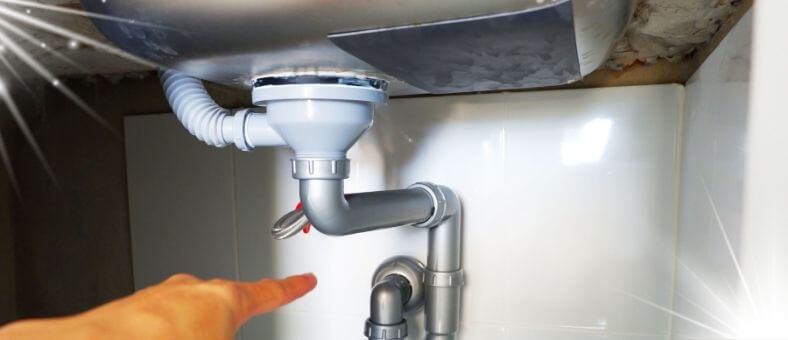
Our last checkpoint in this journey is the drain pump. Imagine it like the heart of your dishwasher’s drainage system, pumping out all the water at the end of each cycle. If it’s not working as it should, the water stays put, lazy and unmoving!
The Crucial Point to Note
Should you feel comfortable and safe doing so, consider checking for any obstructions (perhaps a rogue popcorn kernel?) in the pump. Alternatively, this might be where a professional’s expertise becomes invaluable. Sometimes, allowing a seasoned specialist to handle the technical aspects guarantees safety and proper handling!
Steps to Follow Post-Repair
Navigating through a repair, especially one you’ve tackled yourself, brings a sense of achievement. But the journey still needs to be finished. Let’s ensure your countertop dishwasher is ready to roll, happily assisting your kitchen endeavors without a hitch.
#1. Run a Test Cycle
After successfully navigating through the repair steps, verifying that everything is functioning as it should is pivotal. Running a test cycle is akin to giving your dishwasher a mini-exam, checking if it passes all the functional aspects smoothly.
- Connect and Power Up: Ensure your dishwasher is properly plugged in and powered on. Gently insert the plug into the outlet and check that the settings are correctly configured. A beep or light usually confirms it’s ready. This step is like starting a car engine before hitting the road.
- Observe Water Flow and Drainage: Start a short wash cycle and watch closely. Observe how the water fills and drains—there should be no delays or blockages. Listen for any unusual noises and make sure the water movement is smooth. This ensures your drainage system is functioning properly post-repair.
- Check for Leaks: While the cycle runs and after it ends, inspect the area around the dishwasher. Watch for puddles, drips, or moisture—these may indicate a leak. A dry area confirms the seals and connections are intact, and your repair was successful.
#2. Ensure Optimal Functioning
Repairing your countertop dishwasher is one thing; ensuring it continues to serve you with peak performance is another. Now that we’ve gotten the water to drain correctly let’s ensure every wash brings a sparkle to your dishes without hiccups.
- Listen for Normal Operational Sounds: Listen to your dishwasher’s typical hums, swishes, and gentle noises during each cycle. These are like its natural rhythm. If you hear clanks, loud hums, or anything unusual, it could be a sign something isn’t right. Knowing these sounds helps you catch potential issues early and maintain smooth operation.
- Confirm Effective Draining: Don’t rely on a single test. Run multiple cycles using different settings to ensure the dishwasher consistently drains all the water. Consistent drainage is key to avoiding unexpected water buildup and maintaining proper hygiene.
- Examine Dishes for Cleanliness: After the wash, inspect your dishes carefully. Look for spots, streaks, or leftover food particles. Make sure glasses are clear, and plates come out spotless. Clean results confirm your dishwasher jets are functioning properly and that water is reaching all areas during the cycle.
Prevention and Maintenance
Navigating through kitchen conveniences, our countertop dishwasher is nothing short of a daily hero, washing away our culinary battles with grace. But like every hero, it, too, needs a little care to continue its valorous acts. So, let’s talk prevention and maintenance to ensure that “Countertop Dishwasher Not Draining” doesn’t pop back into our worries!
#1. Regularly Clean and Inspect
Your countertop dishwasher serves you many clean dishes and, in return, asks for just a bit of tender, loving care. Regular checks and a bit of cleaning now and then will not only keep it running smoothly but also enhance its lifespan significantly.
Embrace a Lemon-fresh Future
Regularly using a cup of white vinegar or a fresh lemon during a cycle can naturally remove hard water stains and build-up, ensuring your dishwasher remains a champion cleaner. An effortless trick to embrace a lemon-fresh, sparkling future together!
Establish a Cleaning Routine
Clean dishes come from a clean dishwasher, and establishing a routine can be a game-changer. Monthly, engage in a gentle clean-up: run an empty cycle to refresh its insides using a mild detergent or a mixture of white vinegar and baking soda. Remember to wipe the edges of the door and the seal, as leftover gunk tends to hide there. A happy, clean dishwasher promises a cascade of sparkly clean dishes!
Frequent Filter Checks
Your dishwasher’s filter is like its guardian, catching all the leftover bits and pieces so they don’t jam up the works. Every few weeks, take a moment to check and clean the filter. Just a quick rinse under the tap, perhaps a gentle brush to dislodge any stubborn particles, and it’s back to being the silent guardian of your wash cycles. This tiny act is pivotal in preventing potential drainage issues down the line.
Periodic Hose Inspections
The hose of your dishwasher is akin to its artery, ensuring all that murky water finds its way out. Every few months, gently inspect the hose for any signs of wear, tear, or blockage. Ensure it’s securely attached and the path is clear of any possible kinks or obstacles. A smooth hose ensures a smooth journey for the water, right from your dirty dishes to the drain.
#2. User Best Practices
Embarking on a path of diligent dishwasher use isn’t merely about fixing and preventing issues; it’s also about adopting habits that champion optimal functioning and longevity. Adopting conscientious use practices is tantamount to ensuring a happy, efficient appliance that stands the test of time and usage.
Proper Loading and Unloading
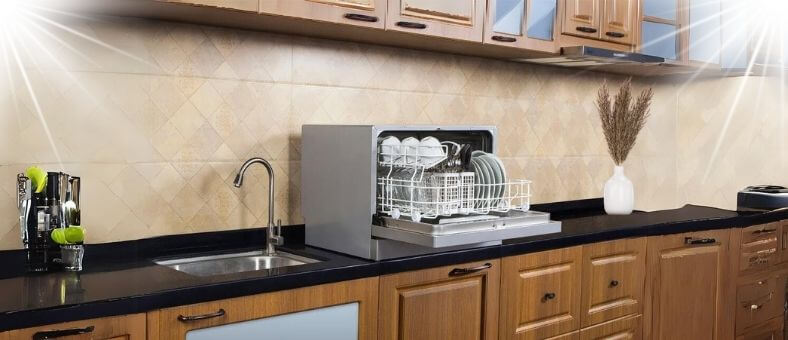
Let’s begin with the basics—how to bestow your dishwasher with a well-organized array of dishes for an optimal clean! Begin by placing larger items like pans and bowls on the bottom rack, ensuring they’re not blocking the spray arms. The top rack is their haven for glassware and cups, preventing any vigorous sprays from harming their delicate structures. When it’s time to unload, start with the bottom rack to avoid any residual water dripping from the glasses above onto your sparkling clean pans. A little thoughtful loading and unloading ensures every item gets thoroughly cleaned while preventing accidental damage or re-soiling of clean dishes.
Using the Recommended Detergents
Detergents can be tricky business. Too much, too little, or the wrong kind can dance on the delicate balance of maintaining your dishwasher in pristine condition. Stick to the user manual’s recommendations on the type and amount of detergent to use. Typically, powders and tablets work wonders for a countertop dishwasher. Excess detergent doesn’t equate to cleaner dishes but may hinder optimal operation and reduce efficiency. By adhering to the manufacturer’s guidelines, you’re not just ensuring clean dishes but also maintaining the inner workings of your appliance, safeguarding it from premature wear and potential issues.
#3. Seek Professional Help When Needed
Sometimes, even with the best efforts, a scenario arises that nudges us towards seeking an expert’s hand in handling our appliance woes. Recognizing when to step back and let a professional step in is crucial in maintaining the health and longevity of your countertop dishwasher and ensuring a secure and safe environment in your kitchen.
Identifying Beyond-DIY Issues
While we all love a good DIY fix, knowing when a problem is out of our league is vital. Warning signs like consistent malfunctioning, strange noises, or even the dishwasher refusing to power on should trigger your call to a professional. Also, if you’ve tried troubleshooting and the problem persists, it’s a loud and clear signal to seek professional help. This is not a defeat, but smart, responsible ownership that prioritizes safety and long-term appliance health.
Understanding When to Replace vs. Repair
Here’s the dilemma: to repair or to replace? A good rule of thumb is to consider a replacement if the repair costs approach or exceed half the price of a new appliance. Also, consider the dishwasher’s age – if it’s nearing or has surpassed its expected lifespan, a new appliance might be a more economical and energy-efficient choice. If your dishwasher has become a frequent repair project, a replacement could save you from future headaches and a dwindling bank account. It’s about balancing economic sensibility and ecological responsibility, ensuring you get the best from your appliance without becoming a resource-draining liability.
Final Thoughts on Countertop Dishwasher Not Draining
Navigating through the challenges of a non-draining countertop dishwasher has undoubtedly been an enlightening journey. Six straightforward steps have guided us towards resolving a pressing issue and embarking on a path where self-sufficiency and understanding of our household appliances are elevated. Addressing drainage issues promptly ensures our dishwasher’s longevity and optimal performance, thereby safeguarding our investments and daily conveniences.
Your time and effort in embracing a DIY approach will undoubtedly serve you well in future troubleshooting and maintenance tasks. Let’s continue to forge ahead, appreciating the seamless functionality of our home appliances and retaining the assurance that we can manage the hurdles along the way. May your dishes always emerge sparkling and your troubleshooting be ever triumphant!
At WashDryDazzle, our primary goal is to equip you with invaluable knowledge to simplify your day-to-day tasks; to explore more, check out our central hub of Dishwasher Guides.
Frequently Asked Questions (FAQs)
How do I identify a dishwasher pump failure?
Identifying a pump failure involves listening for unusual noises, noticing water not draining, finding dishes not fully clean, seeing error codes, or observing visible pump damage.
Can I fix a dishwasher pump alone, or need professional help?
Following guides like our article, you might manage basic pump repairs with some appliance repair knowledge and tools. For safety and assurance, especially with complex issues, professional help is recommended.
What can I do regularly to ensure efficient draining in my countertop dishwasher?
Regularly check and clean the drain filter, ensure the drain hose isn’t kinked or clogged, and run a cleaning cycle with a dishwasher cleaner to prevent build-ups.
What are common signs of water outlet issues in a countertop dishwasher?
Common signs include water not draining fully, unpleasant odors due to stagnant water, pooling water at the bottom of the appliance, and dishes not being cleaned properly due to residual water.
What Brands Offer Countertop Dishwashers?
Several brands offer countertop dishwashers, including COMFEE‘, BLACK+DECKER, Farberware, SPT, Danby, and more. Each brand might offer different models with varied features and capabilities.
Which Countertop Dishwasher Brand Is the Most Reliable?
Reliability can depend on specific models and user experiences. Some brands, like COMFEE’ and BLACK+DECKER, have been noted for their reliability in user reviews, but it’s essential to research and perhaps read reviews on specific models to determine their reliability.
Unlock the Full Potential of Your Dishwasher!
Discover the multifaceted world of modern dishwashers—an innovation hub with features designed for every need. Explore how each feature can be customized to suit your requirements, from eco-friendly modes to advanced sanitization options. Our articles will guide you through what your dishwasher can do, helping you maximize its capabilities while understanding its limits.
Embark on your journey to dishwasher mastery with us today!
- Dishwasher Air Gaps: What They Are and Why We Need Them
- Understanding the Sanitization Function in Dishwashers
- The Dishwasher’s Impact on Knives: What You Need to Know
- Portable vs. Built-in Dishwashers: Which is Better?

